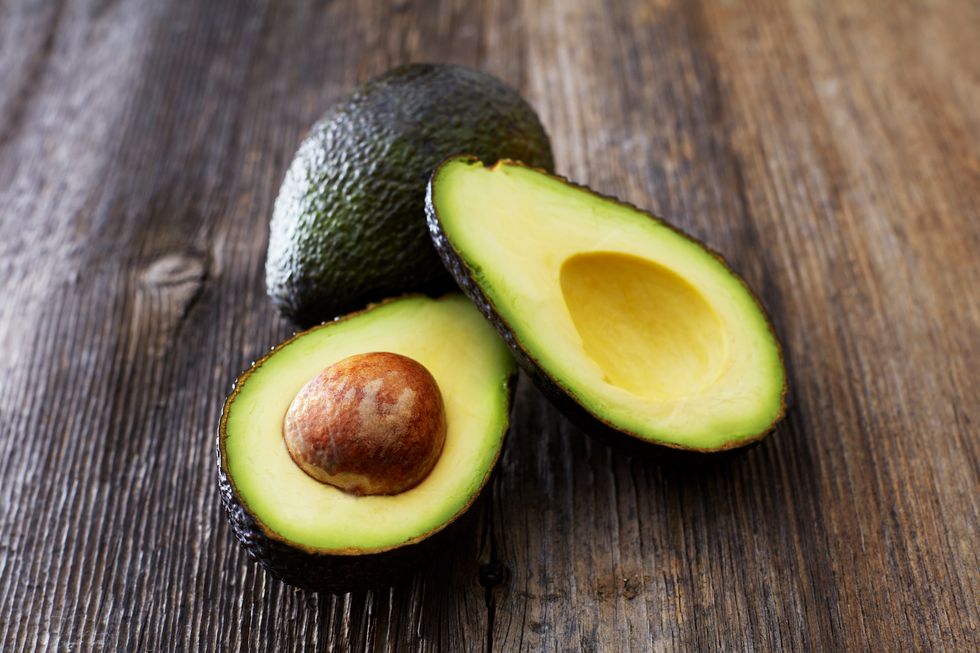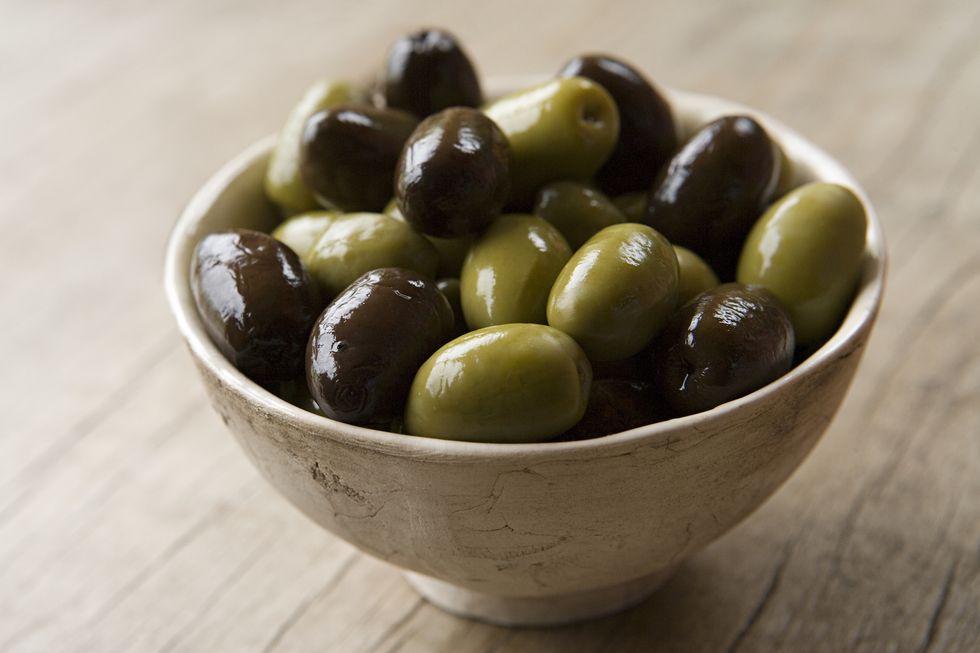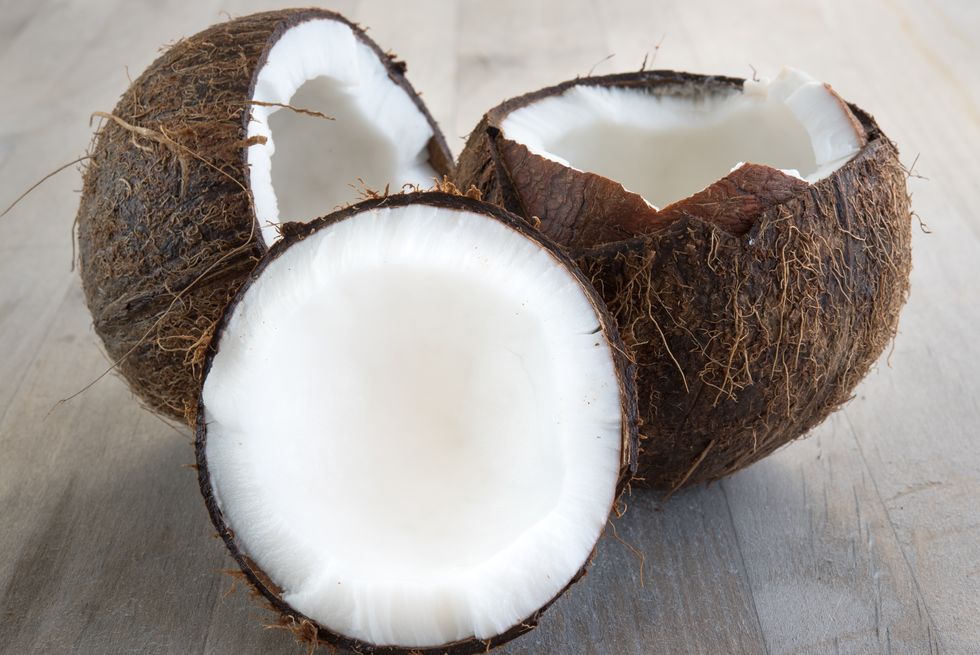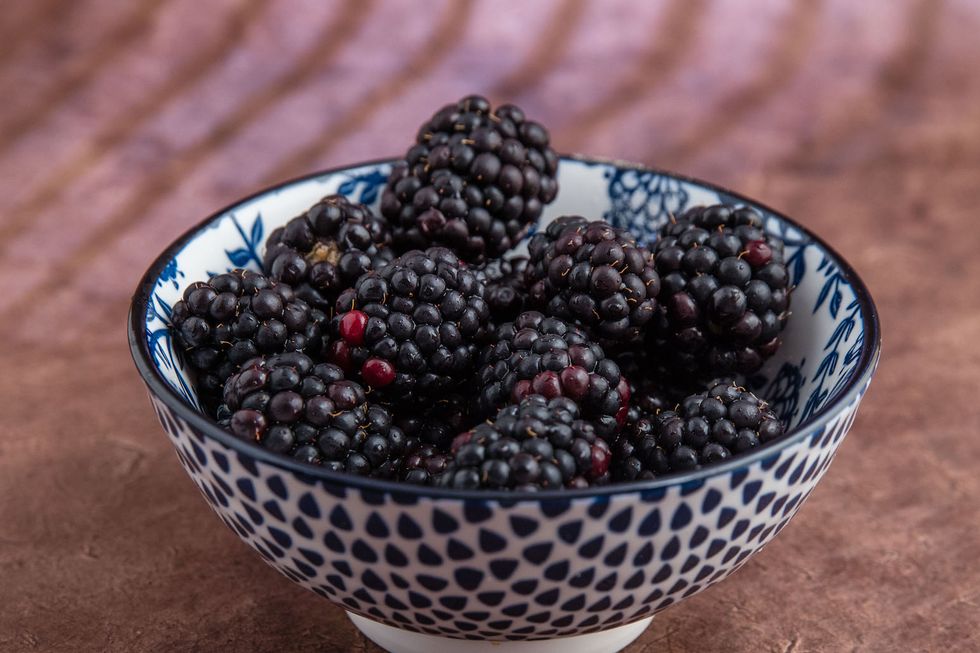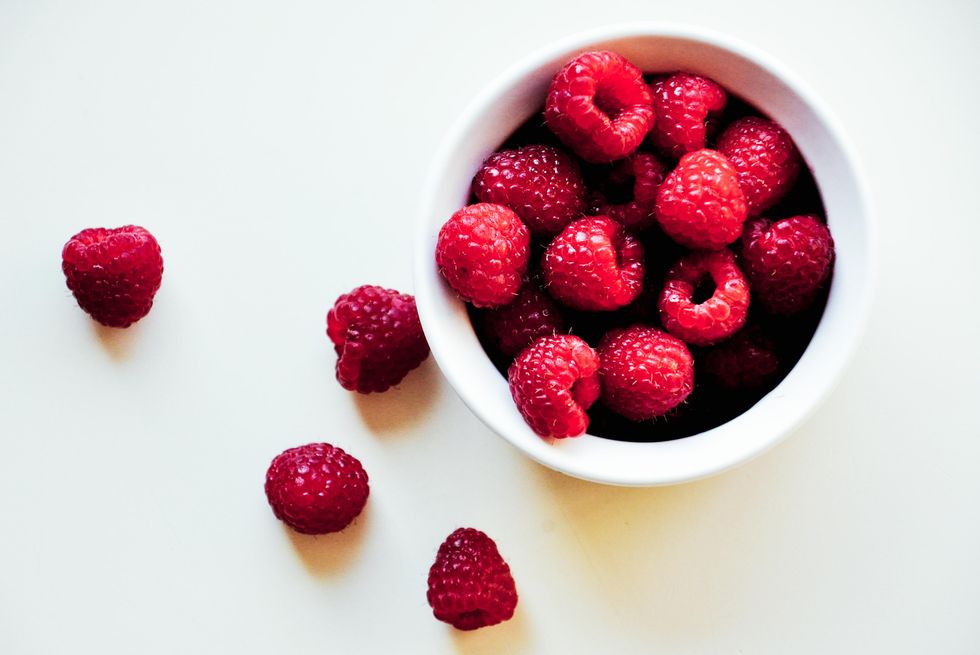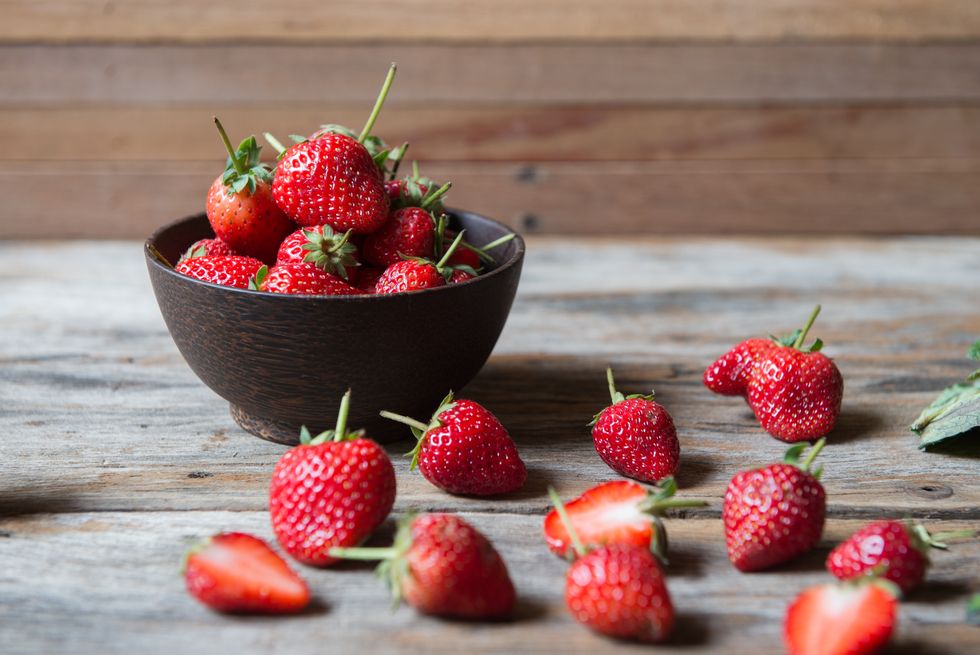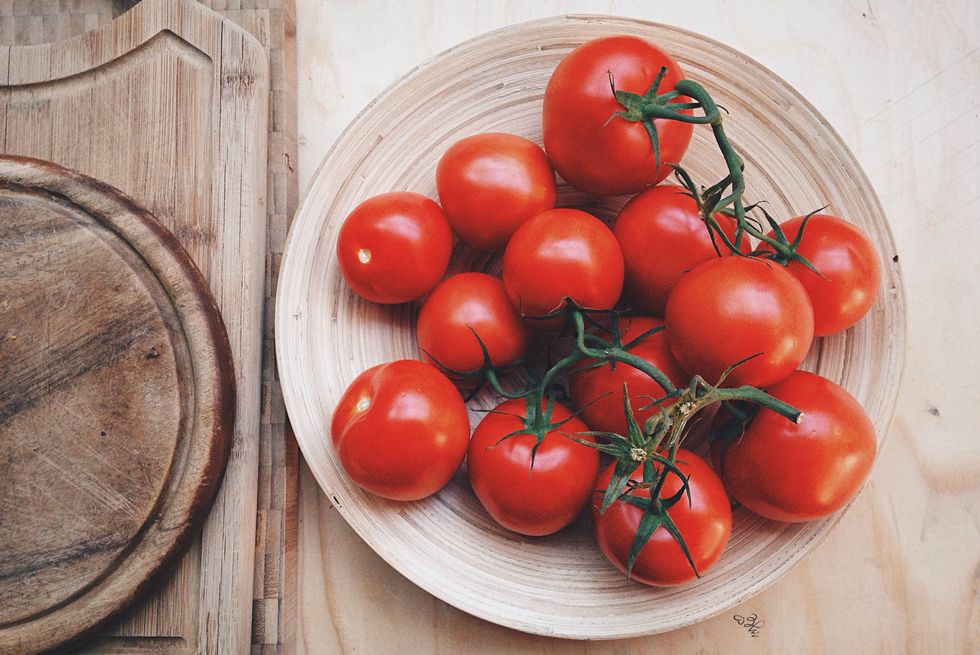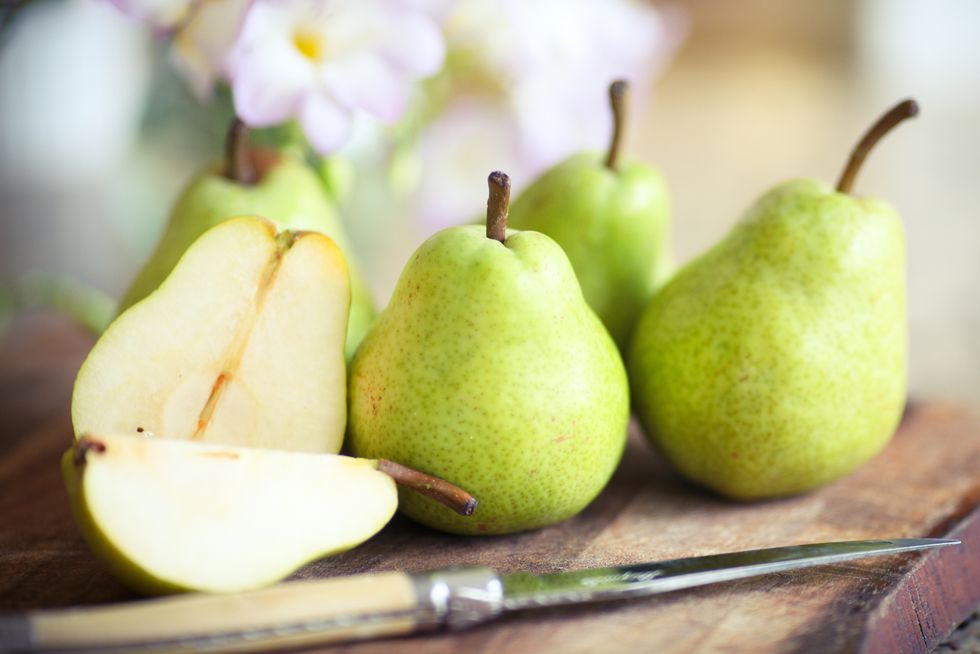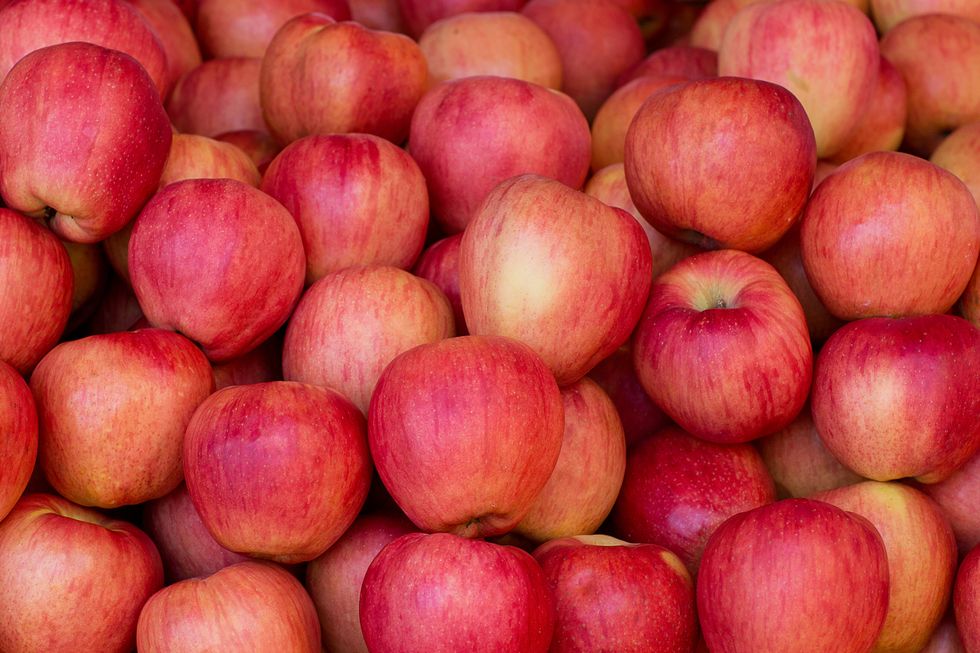If you’re on the keto diet, you know it requires paying close attention to nutrition labels. On this high-fat plan, you’re only getting five to 10 percent of your calories from carbs in order to stay in ketosis: a state where your body burns fat, rather than carbs, for energy. And while fruit is normally considered a healthy food, it’s also pretty high in carbs due to its high natural sugar content. That doesn’t mean this refreshing snack is completely off the table though—you just need to pick keto-friendly fruits.
TBH, a lot of fruits that are low-cal and a staple in other weight-loss diets are not keto-friendly. Take blueberries, for example: One cup contains about 18 grams of net carbs (that’s total carbs minus fiber), which accounts for pretty much an entire day’s worth of carbs on the keto diet, since you’re supposed to eat fewer than 20 grams of net carbs a day. (But, yes, they’re still on this list, because eating them in moderation on keto could reap other health benefits—keep reading!)
“Often, fruit is mostly or completely excluded from the keto diet, which removes many options for high-fiber, -vitamin, -mineral, and antioxidant foods,” says Seattle-based registered dietitian Ginger Hultin, who is also a spokesperson for the AAD and the owner of ChampagneNutrition.
That’s why you should still try to incorporate fruit on keto, because you definitely want the fiber that it provides. “Fiber can help keep us full, keep the bowels regular, and helps manage cholesterol levels,” says Melissa Majumdar, RD, a spokesperson for the Academy of Nutrition and Dietetics (AAD). “Fiber needs are 25 grams for most.”
What is low calorie diet? 5 Recipes with Free Meals Plan 2024
So, knowing the carb content of your fruit is crucial to fitting it in. “Most fruits provide about 15 grams of carbohydrates per 1/2-cup serving, or about the size of a tennis ball,” says Majumdar. “Choosing fruit as your source of carbohydrates is a good choice because of the nutrient punch they pack and the overall lack of fiber on the keto diet.”
Kylie Bensley, MS, RD, clinical dietician and founder of Sulinu Nutrition stresses that the key to getting said nutrient punch is eating the fruit’s skin, if there is any. “The skin of a fruit beholds the majority of nutrients—the fiber, phytonutrients, the micronutrients,” she says. “So don’t be quick to peel that cucumber, apple, or even the kiwi! It is the key to staying in ketosis.”
Now that we’re all on the same page, here are 26 keto-friendly fruits, selected by RDs, that pass the carb test. (Scroll to the end for five fruits to avoid on keto.)
1. Avocado
Yep, this creamy delight is actually a fruit—and it’s a keto diet godsend. Not only does a cup of sliced avocado contain a glorious 22 grams of heart-healthy fat, but it has less than three grams of net carbs, per the United States Department of Agriculture (USDA) food database. Studies have also shown it to lower levels of “bad” LDL cholesterol.
Avocados make great additions to smoothies, says Sarah Jadin, RD, who specializes in keto diets. Still, even with avocado, you need to be mindful of how much you’re eating in relation to your carb allowance, she notes.
2. Olive
Bet you didn’t realize olives fell under the fruit umbrella—but they totally count. Not only are they known for their anti-inflammatory effects, but they’re also great for heart health.
One cup of olives pack about 21 grams of fat and less than one net carb, per the USDA. Bonus: They’re salty, and getting enough sodium is important when following a keto diet, says Jadin.
3. Coconut
Coconut is loaded with fiber (one cup of it shredded has 7.2 grams, per the USDA), which is super healthy for your gut. Plus, it’s also been studied for its MCT (medium chain triglycerides) oil content that may reduce Alzheimer’s risk.
A 1/2 cup of shredded coconut meat yields about 13 grams of fat, and a respectable 2.5 grams of net carbs. Sugar is often added to coconut, so make sure you’re buying unsweetened—or buy an entire coconut and scoop the meat out yourself.
4. Blackberry
Blackberries have an impressive amount of fiber—nearly eight grams in a cup, per the USDA. Plus, they have a ton of vitamin C: One cup has 30.2 mg, which is half of the daily recommended amount. (Step aside, oranges.) They’re also known for their antioxidants and have been found to have anti-inflammatory effects. Plus, the serving size includes six grams of net carbs, so it’s not a bad idea to add these to your morning yogurt.
5. Raspberry
Thanks to their fiber and antioxidant content, raspberries have been studied for health benefits including reduced inflammation and lower risk of obesity and type 2 diabetes.
One cup of raspberries contains 6.6 grams of net carbs—so toss them in a salad, or, even better, make heavy whipping cream and plop a few berries on top for a keto-friendly dessert, recommends Jadin.
6. Strawberry
A cup of strawberry halves contains a little more than nine grams of net carbs—but you can cut that number in half if you aim to eat a 1/2 cup. These berries offer other perks as well: A 2016 study found that eating them reduced insulin resistance—and they’ve also been found to reduce heart disease risk.
7. Tomato
Here we have yet another should-be veggie that’s actually a fruit! Tomatoes are also great for heart health, with one study linking a tomato-rich diet to lower levels of inflammatory stress markers associated with the development of cardiovascular disease. At four grams of net carbs per cup, cherry tomatoes make a great addition to your keto diet, either as a snack or salad topping.
8. Lemon
No one’s asking you to bite into a lemon—though, if you’re into that, you do you—but when you need to dress up unsweetened seltzer water or plain tea, this sour citrus fruit has your back. A squeeze from a wedge has less than half a gram of net carbs. That’s a negligible amount of carbs, so honestly, squeeze as many lemons as you want, says Jadin.
Lemons may also do wonders for your cholesterol levels, according to one study where participants experienced lower lipid levels in their blood after drinking a garlic and lemon mixture for eight weeks.
“Lemons also provide a great source of vitamin C and can help improve the absorption of iron from other foods,” adds Kaitlyn Isabella Randall, RDN for WellTheory. “For example, squeezing some fresh lemon juice on top of steamed spinach before enjoying can maximize your intake of the nutrients in this dark leafy green.”
9. Pear
“A medium pear [has] 25 grams of carbohydrates, but has the most fiber of any fruit—six grams—and tastes great with a nutty dip like almond butter, [which also adds] one gram of fiber (and three grams of carbs) per tablespoon to the snack,” says Majumdar. “Almond butter is a great way to meet fat goals too, with six grams of total fat and only 0.5 grams of saturated fat per tablespoon.”
Pears are rich in a plant compounds called anthocyanins, which studies have found to reduce the risk of type 2 diabetes by 23 percent—say, when eating five servings of anthocyanin-rich fruits, like pears.
10. Apple
“Apples range from 12 to 14 grams of net carbs in a small apple or a cup, quartered. It’s possible that you could enjoy some apple (make sure to include the skin for even more vitamins, minerals, and antioxidants) on a ketogenic diet, but in very small quantities,” says Hultin.
An apple (or two) a day could also keep strokes away. A 2019 study found that eating two apples a day can lower cholesterol, which decreases your risk of heart attack and stroke.
An apple makes a great snack for keto followers when loaded up with a high-fat nut butter.
11. Watermelon
“Watermelon has about 11 net carbs in a cup of melon balls, so it could conceivably fit into a ketogenic diet in small amounts,” says Hultin. “Watermelon is high in both vitamin C, as well as the antioxidant lycopene, which the red color indicates (it’s also found in tomato!).”
Try pairing it with a high-fat yogurt or cottage cheese.
12. Lime
“One lime fruit contains five grams of net carbs, so this citrus fruit does fit on the keto diet,” says Hultin. “It is tart and flavorful, yet high in fiber and vitamin C.”
Utilize lime to flavor water, or mix it into sauces to put on your keto-friendly meals. It goes particularly well in peanut sauce, adds Hultin.
13. Blueberry
“It’s important to maximize fruit and veggie intake on this low-carb diet to get access to the vitamins, minerals, antioxidants, and fiber,” says Hultin. “Blueberries are sometimes excluded from fruit lists because they are a little higher in net carb, but keep in mind that 1/2 cup has about 8 to 11 net carbs, so they could actually be included in small amounts.”
Even just a 1/4 cup of blueberries sprinkled on some cereal or low-carb granola could be a nice boost of the specific nutrients in these delicious berries.
14. Pomegranate
“Pomegranates have phytonutrients that protect our body from cellular damage, and they are super fun to eat,” says Majumdar. “Half a cup of the arils (seeds) has only 16 grams of carbohydrates and over three grams fiber.” That’s around 12 net carbs.
Whip up a sauce for some lean protein or sprinkle the seeds on a meat dish for a refreshing burst of flavor.
15. Cantaloupe
“A cup of cantaloupe melon balls has about 12 to 13 net carbs, so it can definitely fit into the keto diet on occasion, on otherwise very low-carb days,” says Hultin. “Rich in fiber, vitamin C, and potassium, this is a very healthful fruit.”
Munch on cantaloupe during breaks or enjoy it as a sweet dessert. Add it—chilled—to smoothies for a frothy, sweet taste.
16. Cranberry
“A cup of chopped cranberries has about eight grams of net carbs, so this tart, colorful berry can be included on a ketogenic diet,” says Hultin. “Cranberries are very high in vitamin C, and there’s some interesting research showing potential health benefits to the urinary tract system.”
Add some to a salad for a beautiful garnish, or blend them into your next keto fat bomb smoothie.
17. Kiwi
“Kiwis are naturally portioned and a small fruit contains only eight to nine grams of net carbs,” says Hultin. “Kiwis are rich in potassium and vitamin C, as well as a great source of fiber, so they do complement a ketogenic diet.”
Kiwis have also been shown to act as a natural laxative to promote regular elimination, adds Randall. “This is especially important when following such a low-carb diet, because constipation can become an issue,” she says.
Grab ’em and go! Kiwis are perfectly portioned, so you can carry one for a snack on the go, or enjoy it as part of a healthy keto breakfast.
18. Starfruit
Also called carambola, starfruit delivers about nine grams of carbs and about four grams of fiber per one cup, which amounts to five net carbs, says Bensley. Not bad! If you’ve never had starfruit before, its taste leans citrusy—and borderline sour—depending on how ripe it is. It’s also packed with vitamin C, Bensley adds. Like kiwi, it makes a great snack.
19. Fig
At six grams of net carbs per hearty piece, Kat Best, head of nutrition at Alta Coaching, says fresh figs make an ideal keto-friendly snack. They can also be incorporated into sweet and savory meals. Figs pair well with cheese, too, and can be the star of your keto charcuterie board. Pile both ingredients high onto a seed cracker and call it girl dinner.
20. Peach
To be enjoyed sparingly, peaches—skin on—reach 12.5 grams of net carbs per cup, says Best. Like berries, they make a tasty keto-friendly dessert when paired with heavy whipping cream.
21. Cucumber
Yes, cucumber is actually a fruit, and it’s the keto follower’s best friend, as it’s made up of mostly water and has two grams of net carbs, per Bensley. What it lacks in carbs, it makes up for in satisfying crunch—especially when seasoned with your favorite salt and herb blends.
22. Gooseberry
If you’re a fan of grapes, which aren’t very keto-friendly, you can try assuaging that craving with gooseberries. They’re a member of the currant family and are very similar in size, shape, and texture to grapes. Best of all, a whole cup clocks in at 8.5 grams of net carbs, Bensley says.
23. Eggplant
Another fruit in disguise, eggplant is a super versatile, keto-friendly option that can easily be the main attraction at lunch or dinner. Toss it with some chickpea pasta, or roast it for a salad and sprinkle it with cheese. No matter how you serve it, a cup of aubergine will set you back just about 2.3 net carbs, says Bensley.
24. Zucchini
It’s assumed that squash is a vegetable, but by definition, it’s a fruit, because it comes from a flowering plant and contains seeds. That makes zucchini—every low-carb lover’s favorite noodle substitution—a contender for this list.
Pro tip from Bensley: “The smaller- to medium-sized zucchinis have the best flavor—not the biggest,” she says. One cup is equal to 2.7 grams of net carbs, she adds.
25. Pumpkin
Turns out, it’s not just for carving in October. One cup has 7.4 grams of net carbs, per Bensley, and contains 245% of the recommended daily intake of vitamin A, “an essential vitamin,” she adds.
You can roast it and blend it into a creamy soup, or top a salad with it (and its seeds).
26. Kumquat
Referred to as “little gems” of the citrus family, per Bensley, kumquats are an ideal on-the-go snack for keto followers. One cup has 17 grams of net carbs—so they’d have to be eaten in small amounts on keto—and is a good source of vitamin C, antioxidants, and fiber, she says.
What fruits are off-limits on keto?
Fruits to avoid while on keto, due to their high net carb content, include the following, according to Jonathan Valdez, RDN, the owner of Genki Nutrition and a spokesperson for the New York State Academy of Nutrition and Dietetics.
- Mango. One cup = 22 grams of net carbs
- Banana. One medium banana = 24 grams of net carbs
- Pineapple. One cup = 19 grams of net carbs
- Dried fruits (like pitted dates). Half cup = 60 grams of net carbs
- Grapes. One cup = 25.5 grams net carbs
To incorporate fruits into a keto diet, Valdez recommends creating a list of fruits with the lowest net carb. (Ahem, see above!) “Then, try to think about creative ways that these fruits can be combined into your meals, such as using them as an ingredient for low-carb smoothies, breakfast spreads, or muffins,” he says.
You can cut down on the carb content of fruit even further by halving the serving size, which can help you save room in your daily carb allowance, he adds.

Jessica Migala is a health writer specializing in general wellness, fitness, nutrition, and skincare, with work published in Women’s Health, Glamour, Health, Men’s Health, and more. She is based in the Chicago suburbs and is a mom to two little boys and rambunctious rescue pup.
Emily Shiffer has worked as a writer for 10 years, covering everything from health and wellness to entertainment and celebrities. Her work has been featured in Women’s Health, Runner’s World, PEOPLE, and more. She lives in Charleston, South Carolina.

Kayla Blanton is a freelance writer-editor who covers health, nutrition, and lifestyle topics for various publications including Prevention, Everyday Health, SELF, People, and more. She’s always open to conversations about fueling up with flavorful dishes, busting beauty standards, and finding new, gentle ways to care for our bodies. She earned a bachelor’s degree in journalism from Ohio University with specializations in women, gender, and sexuality studies and public health, and is a born-and-raised midwesterner living in Cincinnati, Ohio with her husband and two spoiled kitties.
credite


